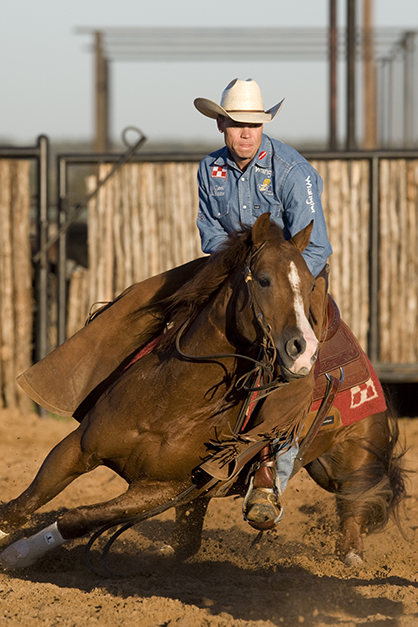6 Ways to Feed Your Horse For Improved Performance

This Cutting horse is engaging in quick bursts of intense activity, which is characteristic of anaerobic exercise. Image courtesy of Purina.
By: Purina Animal Nutrition
Much like human athletes, performance horses have special nutritional needs. And with all athletes, it’s important for diets to match activity and athletic level, to reach the highest level of achievement.
“These six tips may help you to supply your horse with adequate energy to support optimal performance,” says Katie Young, Ph.D., equine nutritionist with Purina Animal Nutrition.
- Know if it’s anaerobic or aerobic exercise
Physical activity is broken into two general categories, aerobic and anaerobic, and it can be helpful to understand the science.
Anaerobic exercise, characterized by short bursts of maximum effort, is primarily fueled by glycogen, a polysaccharide which is composed of sugars and stored in muscle fibers. Soluble carbohydrates from the diet provide the building blocks for glycogen.
Imagine a competitive cutting horse with its incredible agility, quick reactions and strength. A horse like this would be primarily engaged in anaerobic exercise while they’re working a cow. Race horses, even Thoroughbreds running a mile and a half are also highly anaerobic while they’re running the race. Such activity depends on a diet providing adequate soluble carbohydrates for storing and replenishing muscle glycogen needed to fuel these short, intense exercise bouts.
Aerobic exercise, characterized by low to moderate-intensity activity lasting from several minutes to several hours, is primarily fueled by fat. A slow burning fuel, fat can be perfect for keeping the horse going for the long haul.
Three-day eventing, polo, dressage and endurance riding are all examples of primarily aerobic activity. Performance horses engaged in this type of exercise may benefit from feeds with added fat sources.
Keep in mind, no performance activity is either all anaerobic or all aerobic. Each athletic activity has components of both types of work; especially when you consider the warm-up period before an actual competition. However, fueling the horse with the dietary energy source from which they will draw the most fuel is a targeted way to optimize the horse’s ability to perform.
2. Don’t let forages fall flat
While horses in nature may live entirely on forage, equestrians typically demand more from their horses than would ever be required of them in nature. Therefore, additional nutrients and energy are needed to sustain top-level performance in working horses.
Forage can provide adequate fuel for maintenance or low-level activity, but does not supply enough sugar and starch to maintain the glycogen stores required for a hard-working performance horse to succeed. “For horses working at a high level, a feed designed to support that workload will provide adequate soluble carbohydrates and fats to maintain the needed fuel storage for performance,” says Young.
- Electrolytes are essential
Horses need free choice salt, but performance horses have additional mineral requirements. “Any time a horse is working and sweating, consider an electrolyte supplement and feed as directed,” says Young.
Check the ingredients on electrolytes -they should include primarily sodium, potassium and chloride. Always ensure your performance horse has adequate access to fresh, clean water and is well hydrated. Do not give electrolyte supplementation to a dehydrated horse.
- Time the feed
Horses should not be fed a large meal 3-4 hours before an extensive performance event. Feeding any closer to the exercise can hurt the horse’s performance as the blood used for digestion isn’t readily available to the muscle tissue.
If a horse usually has hay available, consider feeding small amounts of hay throughout the day. Feeding forages before an event may not pose the same challenges as a concentrated feed does. Generally speaking, feeding small meals more often is better for the performance horse than one or two large meals a day.
After the event, let the horse cool down before feeding and then consider feeding a small carbohydrate-rich meal 30-120 minutes after exercise to help replace the glycogen used during the event.
- Focus on recovery
Recovery from exercise requires the replenishment of glycogen stores as well of the repair of muscle cells damaged during exercise. Research in humans and horses has shown that ingesting specific amino acids after exercise can decrease muscle recovery time. “Horses performing intense, repetitive work have been shown to benefit from a specific amino acid profile available in a dietary supplement from Purina,” says Young.
- Rethink top-dressing
Horse owners often try to provide additional fat to their performance horses. However, simply top-dressing with oil or an unfortified fat supplement increases the fat and calorie content of the ration, but it doesn’t provide protein, vitamins or minerals to maintain the nutritional balance of the total diet. The best option is to feed a nutritionally balanced feed with a high fat content as well as the proper amount of protein, amino acids, and other nutrients essential to support optimal performance.
“Paying attention to these six areas may help your working horse achieve its true performance potential,” says Young.
For more information on feeding performance horses, contact us at: www.purinamills.com/horse-feed.
Purina Animal Nutrition LLC (www.purinamills.com) is a national organization serving producers, animal owners and their families through more than 4,700 local cooperatives, independent dealers and other large retailers throughout the United States. Driven to unlock the greatest potential in every animal, the company is an industry-leading innovator offering a valued portfolio of complete feeds, supplements, premixes, ingredients and specialty technologies for the livestock and lifestyle animal markets. Purina Animal Nutrition LLC is headquartered in Shoreview, Minn. and a wholly owned subsidiary of Land O’Lakes, Inc.










